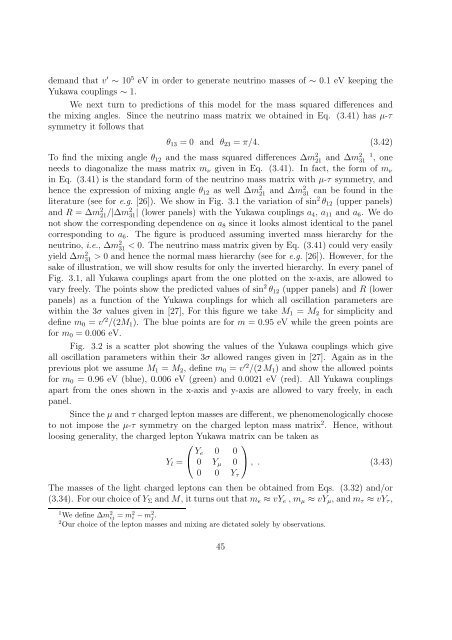PHYS08200604017 Manimala Mitra - Homi Bhabha National Institute
PHYS08200604017 Manimala Mitra - Homi Bhabha National Institute
PHYS08200604017 Manimala Mitra - Homi Bhabha National Institute
Create successful ePaper yourself
Turn your PDF publications into a flip-book with our unique Google optimized e-Paper software.
demand that v ′ ∼ 10 5 eV in order to generate neutrino masses of ∼ 0.1 eV keeping the<br />
Yukawa couplings ∼ 1.<br />
We next turn to predictions of this model for the mass squared differences and<br />
the mixing angles. Since the neutrino mass matrix we obtained in Eq. (3.41) has µ-τ<br />
symmetry it follows that<br />
θ 13 = 0 and θ 23 = π/4. (3.42)<br />
To find the mixing angle θ 12 and the mass squared differences ∆m 2 21 and ∆m2 31 1 , one<br />
needs to diagonalize the mass matrix m ν given in Eq. (3.41). In fact, the form of m ν<br />
in Eq. (3.41) is the standard form of the neutrino mass matrix with µ-τ symmetry, and<br />
hence the expression of mixing angle θ 12 as well ∆m 2 21 and ∆m2 31 can be found in the<br />
literature (see for e.g. [26]). We show in Fig. 3.1 the variation of sin 2 θ 12 (upper panels)<br />
and R = ∆m 2 21/|∆m 2 31| (lower panels) with the Yukawa couplings a 4 , a 11 and a 6 . We do<br />
not show the corresponding dependence on a 8 since it looks almost identical to the panel<br />
corresponding to a 6 . The figure is produced assuming inverted mass hierarchy for the<br />
neutrino, i.e., ∆m 2 31 < 0. The neutrino mass matrix given by Eq. (3.41) could very easily<br />
yield ∆m 2 31 > 0 and hence the normal mass hierarchy (see for e.g. [26]). However, for the<br />
sake of illustration, we will show results for only the inverted hierarchy. In every panel of<br />
Fig. 3.1, all Yukawa couplings apart from the one plotted on the x-axis, are allowed to<br />
vary freely. The points show the predicted values of sin 2 θ 12 (upper panels) and R (lower<br />
panels) as a function of the Yukawa couplings for which all oscillation parameters are<br />
within the 3σ values given in [27], For this figure we take M 1 = M 2 for simplicity and<br />
define m 0 = v ′2 /(2M 1 ). The blue points are for m = 0.95 eV while the green points are<br />
for m 0 = 0.006 eV.<br />
Fig. 3.2 is a scatter plot showing the values of the Yukawa couplings which give<br />
all oscillation parameters within their 3σ allowed ranges given in [27]. Again as in the<br />
previous plot we assume M 1 = M 2 , define m 0 = v ′2 /(2M 1 ) and show the allowed points<br />
for m 0 = 0.96 eV (blue), 0.006 eV (green) and 0.0021 eV (red). All Yukawa couplings<br />
apart from the ones shown in the x-axis and y-axis are allowed to vary freely, in each<br />
panel.<br />
Since the µ andτ charged lepton masses aredifferent, we phenomenologically choose<br />
to not impose the µ-τ symmetry on the charged lepton mass matrix 2 . Hence, without<br />
loosing generality, the charged lepton Yukawa matrix can be taken as<br />
⎛<br />
Y l = ⎝ Y ⎞<br />
e 0 0<br />
0 Y µ 0 ⎠, . (3.43)<br />
0 0 Y τ<br />
The masses of the light charged leptons can then be obtained from Eqs. (3.32) and/or<br />
(3.34). Forourchoice ofY Σ andM, itturnsoutthatm e ≈ vY e , m µ ≈ vY µ , andm τ ≈ vY τ ,<br />
1 We define ∆m 2 ij = m2 i −m2 j .<br />
2 Our choice of the lepton masses and mixing are dictated solely by observations.<br />
45
















